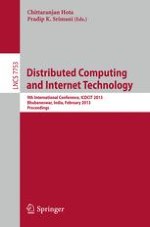2013 | Book
Distributed Computing and Internet Technology
9th International Conference, ICDCIT 2013, Bhubaneswar, India, February 5-8, 2013. Proceedings
Editors: Chittaranjan Hota, Pradip K. Srimani
Publisher: Springer Berlin Heidelberg
Book Series : Lecture Notes in Computer Science
